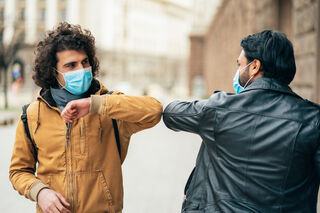Friends
How Friendship Has Changed in the Pandemic
New research reveals that some people have it worse.
Posted February 24, 2021 Reviewed by Gary Drevitch
Key Points:
- Younger adults were more likely than older individuals to report that their friendships had suffered during the pandemic.
- Because of the ways they tend to interact with friends, men's friendships appear to have suffered more during the pandemic than women's.
- In the pandemic, rather than experiencing friendships as an outlet for managing risk, many have come to view them as a source of risk.
How much do you miss your friends? A lot, I’m willing to bet. The forced lack of in-person social connection that the Covid-19 pandemic enforced has been painful and prolonged. Friends are supposed to be able to be there for each other in a crisis, but this crisis looks and feels different. Coming together in person is exactly what we haven’t been able do.
The isolation has been difficult for just about everyone. But it looks like it has been harder for some of us than for others. Men, young people, and less educated people have experienced more negative effects on their friendships during the pandemic than other groups. For instance, they reported feeling lonelier and less satisfied with their friends. Those feelings in turn made the same people more likely to engage in risky social behavior such as attending large parties.
Those results come from a preliminary report on a study led by social psychologists at Arizona State University. It surveyed more than 600 people from multiple countries in both March and August of 2020 and asked them to report on the state of their friendships. Because the study is still undergoing peer review, the analysis may change a bit before publication. But I was curious about some of the trends that the researchers identified.
Why might some groups have suffered more than others?

Young and Lonely
We usually assume social isolation is hardest for people who are older. In the pandemic, older people were at higher risk and most took higher levels of precaution about socializing. But the researchers found that while older people did report being lonely, it was younger adults who felt their friendships had taken the biggest hit.
Young adulthood has long been recognized as a time for establishing new, long-term friendships, and that has been especially difficult to do over the last year. And in adolescence, which runs from the age of 10 all the way to 25, the brain is more sensitive to social acceptance and rejections than at any other age. “Friendships just might be more important [when you’re young],” says Jessica Ayers, a doctoral student in social psychology at ASU who led the study. “They might perceive their friendships to be taking a bigger hit simply because it’s more salient.”
Another explanation might be the fluctuating social situation many young people experience, says Ayers. New college students, for example, are in transition. “[In their] high school world, they’ve been around the same group of people since probably early childhood,” Ayers says. “They’ve been immersed in that social hierarchy. They know how to navigate it. And they are all of a sudden thrust into this new world. You might not understand the rules.” All of that is hard enough without a pandemic introducing even more rules and restrictions, or closing the door on new opportunities.
Men vs. Women
Gender differences showed up in the study as well. There is a popular line to describe the difference between male and female friendship. Women do friendship face to face; men do friendship side by side. In other words, women talk to each other a lot and men do things together—they watch sports or play sports or sit on neighboring barstools. These stereotypes are certainly not universal, but they are based in truth, both biologically and culturally.
“Men and women have different adaptive pressures that have shaped their social strategies and shape the way they interact with their friends,” Ayers says. On the other hand, they tend to value similar things in friends, such as reliability, loyalty and trustworthiness.
Clearly, the pandemic has been a terrible time for being side-by-side whereas women could keep talking by picking up the phone or jumping on Zoom. “You can’t go out and do tasks together,” says Ayers. “You can’t go out and do activities together.”
The Risks of Friendship
The survey looked also looked at risk and turned up some intriguing ways in which the pandemic has turned standard assumptions upside down. “Friendships in general are theorized to be a way that people can manage risk,” Ayers says. “You can ask for help. Get advice.” Psychologists call such behavior “risk transfer” in that by turning to others for help, you spread some of your own risk. That’s usually healthy. But in the pandemic, those who tended to engage in risk transfer (like a young person who needed help from his parents shopping for food) suffered more, mainly because they felt guilty for putting friends and family at risk.
Young, old, male or female, the pandemic has helped to remind us all about the benefits of friendship and social connection. “Maybe our most valued friendships are going to have a positive boost from the pandemic,” Ayers says. “Because we haven’t been able to see them, when we finally do, those interactions are going to be more meaningful and we’ll put more effort into them.”
I can’t wait and I bet you can’t either.
Copyright Lydia Denworth 2021




